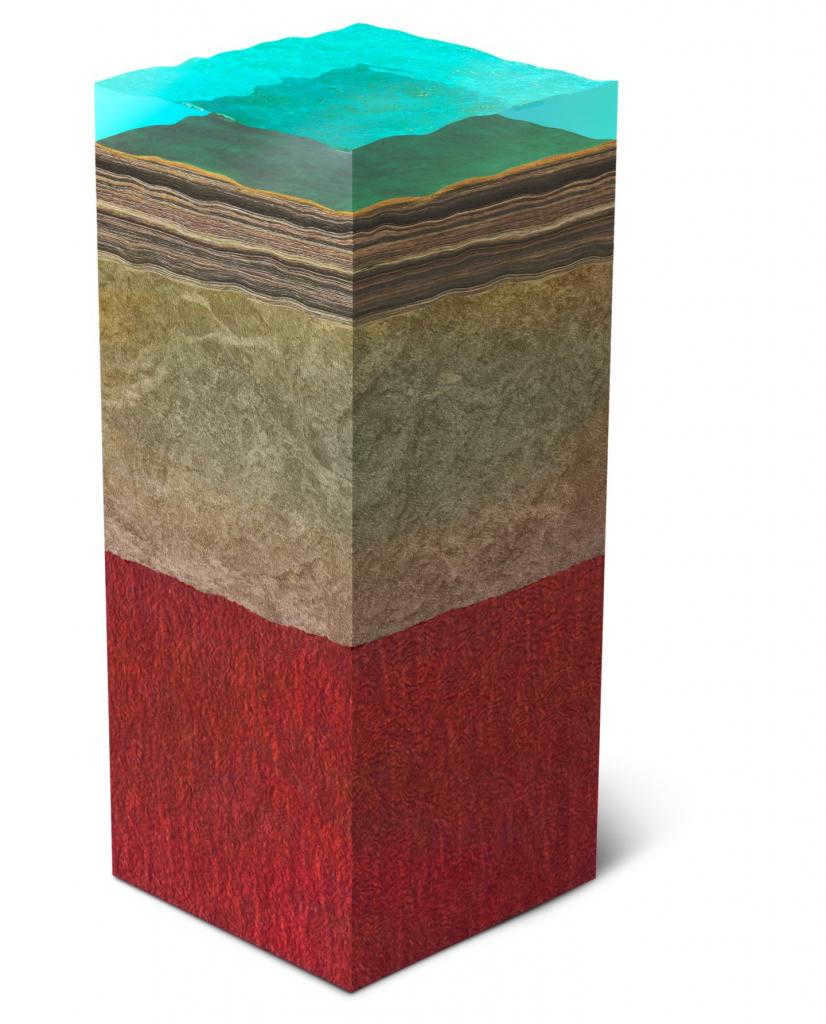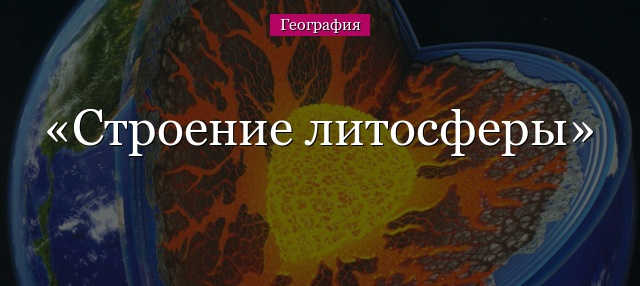
The Earth’s lithosphere is a rigid outer layer that encases the planet. It acts as a shield, safeguarding the surface from extreme temperatures emanating from the planet’s core. Exploring the composition and characteristics of the lithosphere can provide insights into its distinctions from other celestial bodies.
Key features
The lithosphere is situated between the hydrosphere and atmosphere above it, and the asthenosphere below it. Its thickness varies significantly, ranging from 10 to 200 km across different regions of the planet. The lithosphere is thicker on land masses compared to the oceanic regions. Rather than being a singular entity, the lithosphere is composed of separate plates that rest upon the asthenosphere and slowly move alongside it. There are seven major lithospheric plates and several smaller ones. The boundaries between these plates are characterized by zones of seismic activity. In Russia, two such plates converge – the Eurasian and North American plates. The structure of the Earth’s lithosphere consists of three layers:
Let’s delve into each layer in greater detail.
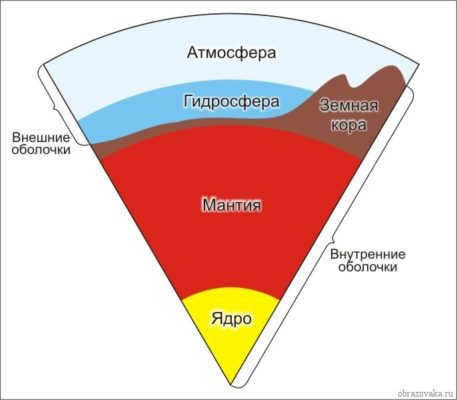
Crust of the Earth
This layer is known as the uppermost and thinnest part of the lithosphere. It constitutes a mere 1% of the total mass of the Earth. The thickness of the Earth’s crust can vary between 30 to 80 km. In areas with flat topography, the crust tends to be thinner, while in mountainous regions, it is thicker. The Earth’s crust can be categorized into two types: continental and oceanic.
While the Earth possesses two distinct types of crust, other planets typically have a single type of crust.
The continental crust is comprised of three layers:
which, when combined with the aforementioned information, can be understood more comprehensively.


- Sedimentary layers are created by sedimentary and volcanic rocks;
- Granitic layers consist of metamorphic rocks such as quartz and feldspar;
- Basaltic layers are composed of igneous rocks.
The oceanic crust contains solely sedimentary and basaltic layers.
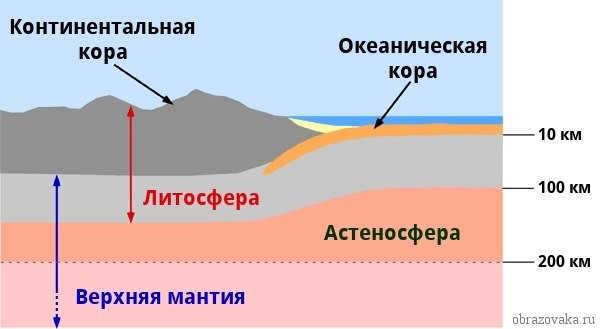
The Earth’s outermost layer, known as the crust, is home to a vast array of minerals, metals, and chemicals. This layer is composed of several elements, including oxygen, iron, silicon, magnesium, sodium, calcium, and potassium.
It is fascinating to note that the Earth’s crust undergoes a complete renewal process every 100 million years.
The Mohorovicich surface: Understanding the boundary layer
The boundary layer, also known as the Mohorovicich surface, is a fascinating area of the Earth’s crust. Within this zone, seismic waves experience a dramatic increase in speed. Additionally, the density of the lithosphere substance undergoes a transformation, becoming more elastic in nature. The Mohorovicich surface is typically found at depths ranging from 5 to 70 kilometers, mirroring the intricate topography of the Earth’s crust.
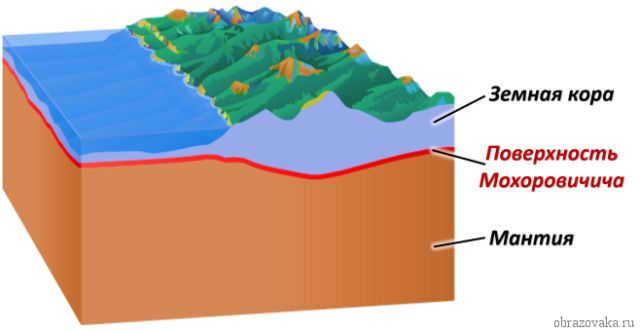
Stratum
Only the upper stratum of the mantle is part of the lithosphere. Its thickness ranges from 70 to 300 km. What phenomena occur within this stratum? It is the birthplace of seismic activity – earthquakes. This is caused by an increase in the velocity of seismic waves in this region. What is the composition of this stratum? It is primarily composed of iron, magnesium, calcium, and oxygen.
The lithosphere of our planet is stratified, consisting of the Earth’s crust and the uppermost part of the mantle. Separating these layers is a distinctive boundary known as the Mohorovicich surface. The overall thickness of the lithosphere measures up to 200 km and within it can be found a wide range of metals and trace elements.
The upper solid shell of the Earth, known as Earth’s crust, is defined as the region between the surface of the Earth and the Mohorovicich surface. This term, “Earth’s crust,” was first introduced in the 18th century by M.B. Lomonosov and later in the 19th century by C. Lyell. During the 19th century, with the development of the contraction hypothesis, the term gained a specific meaning, referring to the idea that the Earth cooled and formed a crust (J. Dana). Our understanding of the composition, structure, and physical properties of the Earth’s crust is based on geophysical data, particularly the propagation velocities of seismic waves (mainly longitudinal waves, Vp), which increase abruptly from 7.5-7.8 to 8.1-8.2 km/s at the Mohorovicich boundary, marking the transition to the Earth’s mantle. The nature of the lower boundary of the crust is thought to be influenced by changes in the chemical composition of rocks (such as the transition from basic rocks to ultrabasic rocks) or by phase transitions (such as the gabbro-eclogite system).
The Earth’s crust exhibits horizontal heterogeneity (anisotropy), manifesting in variations in composition, structure, thickness, and other properties across its distinct structural elements: continents, oceans, platforms, mobile belts, depressions, and rises, among others. Continental and oceanic crust are the primary categories that characterize the Earth’s crust.
The Earth’s continental crust
What is Oceanic Crust?
Oceanic crust is the outermost layer of the Earth’s lithosphere that is located under the oceans. It is composed mainly of basalt, a type of igneous rock that is formed from the cooling and solidification of lava. The oceanic crust is thinner and denser than the continental crust, with an average thickness of about 7 kilometers. It is constantly being created at mid-ocean ridges through volcanic activity and being destroyed at subduction zones where it is forced beneath the continental crust. The oceanic crust plays a crucial role in plate tectonics and the overall structure of the Earth’s surface.
The primary distinctions between oceanic crust and continental crust include the lack of a “granite” layer, significantly reduced thickness (averaging 5-7 km), younger age (Jurassic, Cretaceous, Cenozoic; less than 170 million years), and greater lateral uniformity. The oceanic crust, which has been extensively studied through deep-sea drilling, dredging, and observation from underwater vehicles along fault walls, consists of three layers. The initial layer, known as the sedimentary layer, is comprised of pelagic siliceous, carbonate, and clayey sediments (Vp 1.6-5.4 km/s). In the direction of continental slopes, its thickness increases to 10-15 km. The sedimentary layer may be absent in the axial zones of mid-ocean ridges. In the deep-water trenches of back-arc basins, some of which are underlain by oceanic crust, the sedimentary layer’s thickness, typically including turbidites, may reach 15-20 km. The second layer (Vp 4.5-5.5 km/s) in the upper portion is composed of basalts (often pillow-basalts) with occasional interlayers of pelagic sediments; in the lower part of the layer, a complex of parallel dolerite dikes is present (total thickness 1.2-2 km). The third layer (Vp 6-7.5 km/s) in the upper portion consists of massive gabbros, while the lower portion comprises a stratified complex in which gabbros alternate with ultrabasic rocks (total thickness 2-5 km). Within the internal ridges of the oceans, the Earth’s crust thickens up to 25-30 km due to an increase in the thickness of the second and third layers. Ophiolites serve as the ancient equivalent of oceanic crust on continents.
Oceanic crust is created at the boundaries where lithospheric plates diverge (stretching along the central parts of mid-ocean ridges), where basaltic magma rises to the surface and solidifies. Continental crust is formed during the process of transforming oceanic crust on active continental margins.
Types of Crust in Transition
Aside from the main two types of crust, transitional types are also identified. Suboceanic crust is a thinned continental crust, reaching up to 15-20 km due to riftogenesis, invaded by dikes and sills of basic igneous rocks; it is found along continental slopes and foothills, and also lies beneath deep-water trenches of certain back-arc basins. Subcontinental crust (less than 25 km thick and not fully consolidated) is found in volcanic island arcs, where oceanic crust transforms into continental crust.
Processes shaping the Earth’s crust
The Earth’s crust undergoes both horizontal and vertical movements caused by tectonic forces. These movements give rise to earthquake epicenters and the formation of magmatic centers. Additionally, rocks in the crust can undergo localized or widespread metamorphism. The tectonic movements and endogenous processes in the Earth’s crust are influenced by the presence of a partially molten asthenosphere in the Earth’s interior. As a result of these forces and deformations, magmatic activity, metamorphism, and exogenous processes such as glacier movement, landslides, karst formation, and river erosion, the rocks in the Earth’s crust can experience folding and tectonic dislocations. The Earth’s crust is also subject to weathering due to the effects of the atmosphere, hydrosphere, and biosphere.
To learn more about the evolution of the Earth’s crust throughout geological history, refer to the entry on Earth.
Khain Victor Efimovich. The initial release of this information can be found in the Big Russian Encyclopedia, 2008.

It’s difficult to fathom the vast array of advantages that humans gain from extracting resources from the Earth’s crust. Just the other day, it occurred to me that the laptop I’m currently using to write these words is made primarily of aluminum, the Earth’s most abundant metal. Additionally, my home is heated by natural gas, which is extracted from the depths of the Earth. This realization has sparked a curiosity in me to delve deeper into the geological makeup of our planet.

Formation and Types of the Earth’s Crust
Over the course of hundreds of millions of years, our planet has undergone a series of transformations leading to its present state. Prior to the formation of the Earth’s crust, there existed a molten magma that gradually cooled and solidified. These solidified fragments of magma formed the foundation of the Earth’s crust, known as the basalt layer.
The basalt layer predominates in the World Ocean, where the lithospheric plates are considerably thinner compared to continental plates, measuring approximately 10-15 km in thickness.
The continental crust is three times thicker than the oceanic crust, and is composed of granite and sedimentary layers. These layers have formed as a result of numerous collisions between lithospheric plates in the ocean, followed by their emergence onto land.
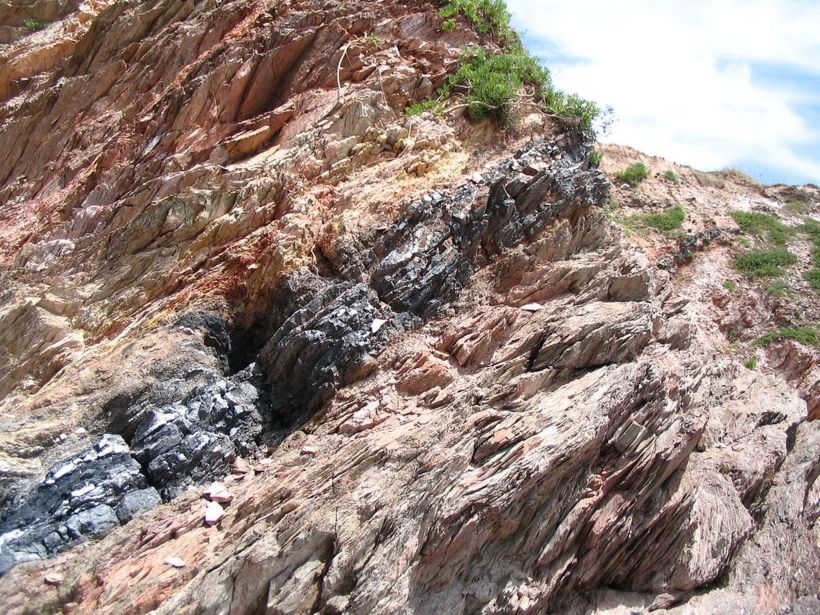
The Earth’s surface is constantly being covered by detrital rocks, which are formed from the erosion of mountain tops.
Investigating the Earth’s Crust
One way to study the upper layer of the lithosphere is by drilling a borehole.
Soviet scientists took this approach and drilled a 12 km well in the Murmansk region, which is 1 km deeper than the Mariana Trench.

A practical investigation into the underground has revealed that many scientists were mistaken about the temperature at depth and the presence of certain minerals.
During the examination of the Kola well, it was discovered that the temperature begins to increase by 1 degree for every kilometer of descent after 6 km, rather than the previously theorized 10 km. Additionally, unexpected deposits of gold were found at depths exceeding 10 km. These gold deposits are twice as concentrated as those found on the surface.
More recently, while examining the lithospheric map of the Earth, an intriguing discovery was made: the oceanic crust, despite its wide distribution, is actually quite thin. This prompted further research into the different types of Earth’s crust and its internal structure. And this is the topic I would like to discuss.
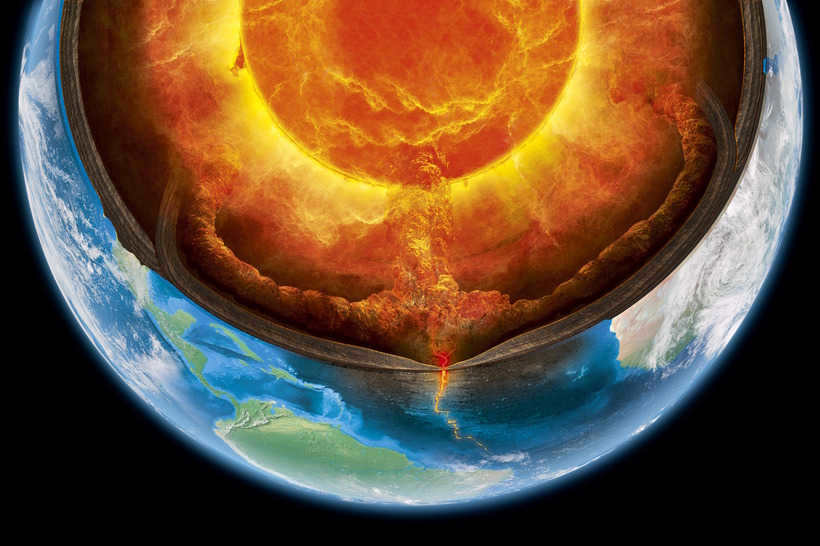
Characteristics of the Earth’s Crust
Let’s start by understanding what the earth’s crust is. Essentially, it refers to the uppermost layer of the Earth’s lithosphere. Importantly, the Earth’s crust is the most accessible for exploration by humans.
When it comes to its types, there are primarily two: Oceanic and continental. Now, let’s delve into each of them in more detail.
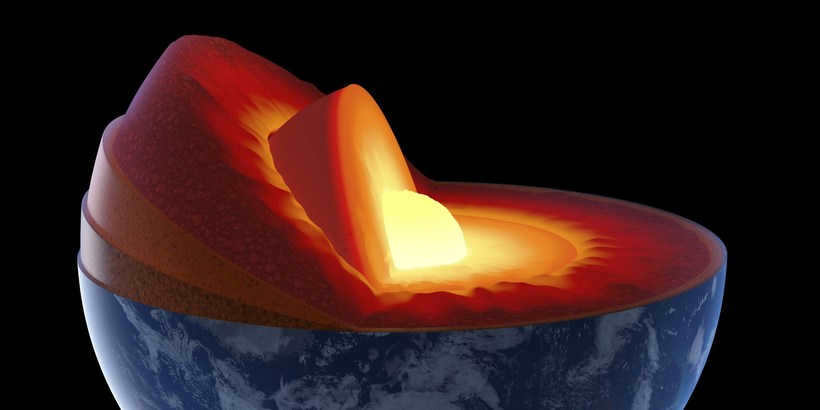
The depth of the oceanic crust is significantly less (ranging from 0.5 to 12 kilometers). It consists of two layers: sedimentary and basaltic.
On the other hand, the continental crust is much thicker (ranging from 25 to 75 kilometers). Its thickness is determined by the specific terrain. Moreover, the continental crust is composed of three distinct layers:
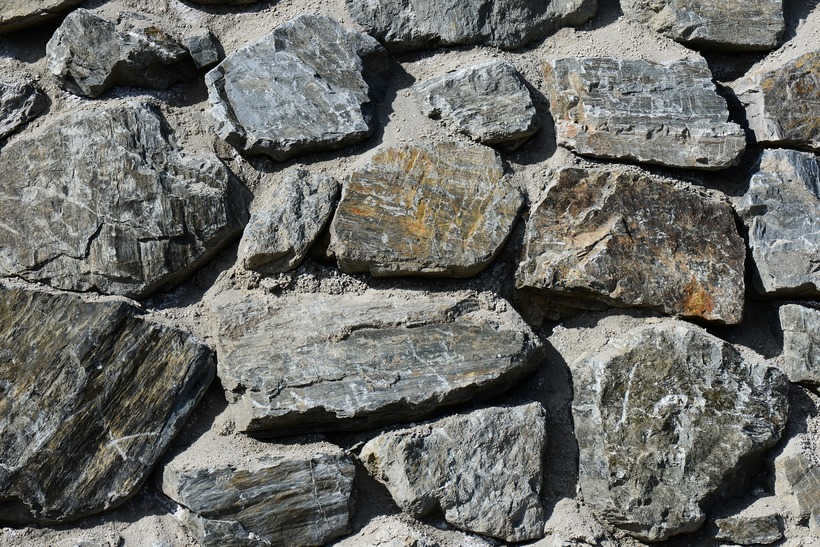
- Basaltic(the lowest, ranging from 10 to 35 kilometers);
- Granite(the “middle”, ranging from 5 to 15 kilometers);
- And sedimentary(surface, ranging from 10 to 15 kilometers).
The oceanic crust is considered the oldest, having appeared in the early stages of Earth’s existence. This happened as the lithospheric plates collided and formed the continental crust. It is important to note that the oceanic crust is predominantly composed of basaltic rocks.
The regions where the oceanic crust initially formed are commonly known as “spreading zones,” while the areas where it first formed are called “subduction zones.” It is interesting to mention that the thickness of the oceanic crust remains relatively constant over time.
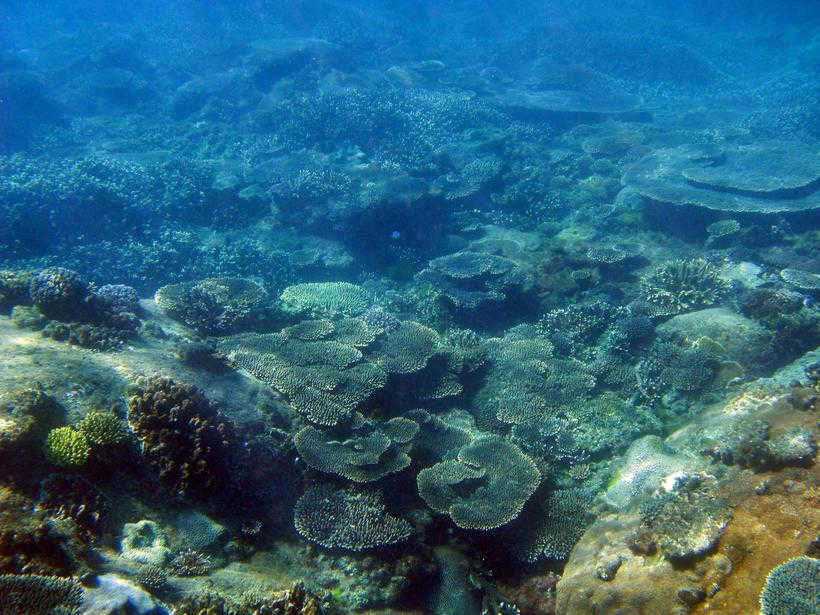
Analysis of the Earth’s Crust
By conducting thorough research, scientists have determined the elemental composition of the Earth’s crust, specifically its uppermost layer:
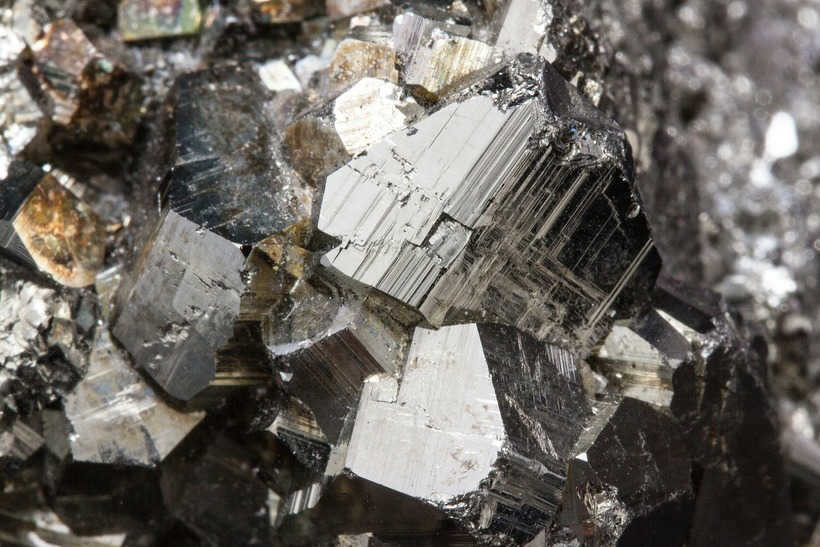
- At the top of the list is oxygen(making up over 49%);
- Coming in second is silicon(accounting for about 25%);
- Taking the third spot is aluminum(comprising around 7.5%;)
- And lastly, we have iron(making up just under 5%).
Next in line are substances like calcium, magnesium, phosphorus, nitrogen, and others. However, their proportions are not as significant.
Geography is a scientific field that explores the connection between natural features and the Earth’s surface as well as human activity.
The lithosphere, which consists of the Earth’s crust and the upper layer of the mantle, plays a crucial role in shaping the surface relief. It is the lithospheric blocks that contribute to the formation of the Earth’s surface.


What are tectonic plates in geology?
Tectonic plates are massive and stable sections of the Earth’s crust. These segments are situated on top of the moving upper mantle, which is a liquid layer composed of igneous rocks. Consequently, these segments are in continual horizontal motion. The plates are shifting in relation to one another, with a displacement rate ranging from 5 to 18 cm per year.
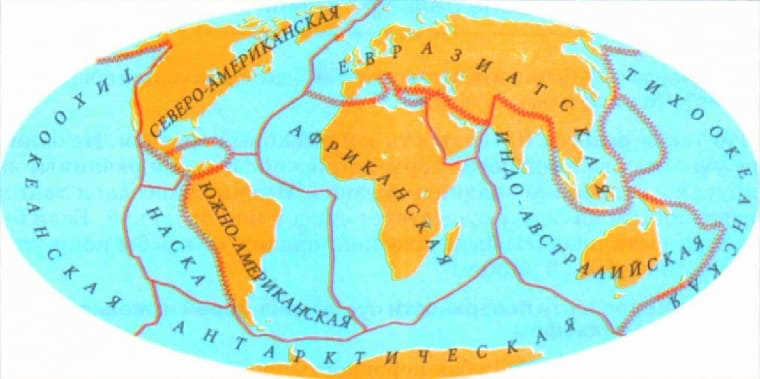
What are the components of lithospheric plates?
There are two types of Earth’s crust: continental, which makes up the continents, and oceanic, which is found beneath the world’s oceans. Some lithospheric plates consist solely of oceanic crust, such as the Pacific Plate, while others are composed of both continental and oceanic crust. The thickness of the Earth’s crust ranges from 150-350 km for continental crust to 5-90 kilometers for oceanic crust. The movement of lithospheric plates results in tectonic interactions between them, which play a significant role in shaping the Earth’s surface.
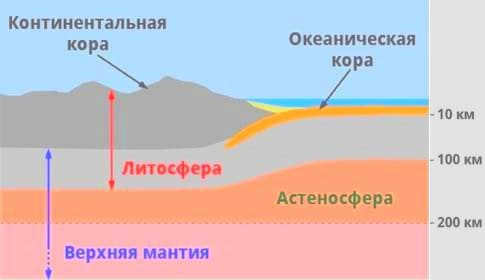
Map of the Earth’s lithospheric plates and their corresponding names.
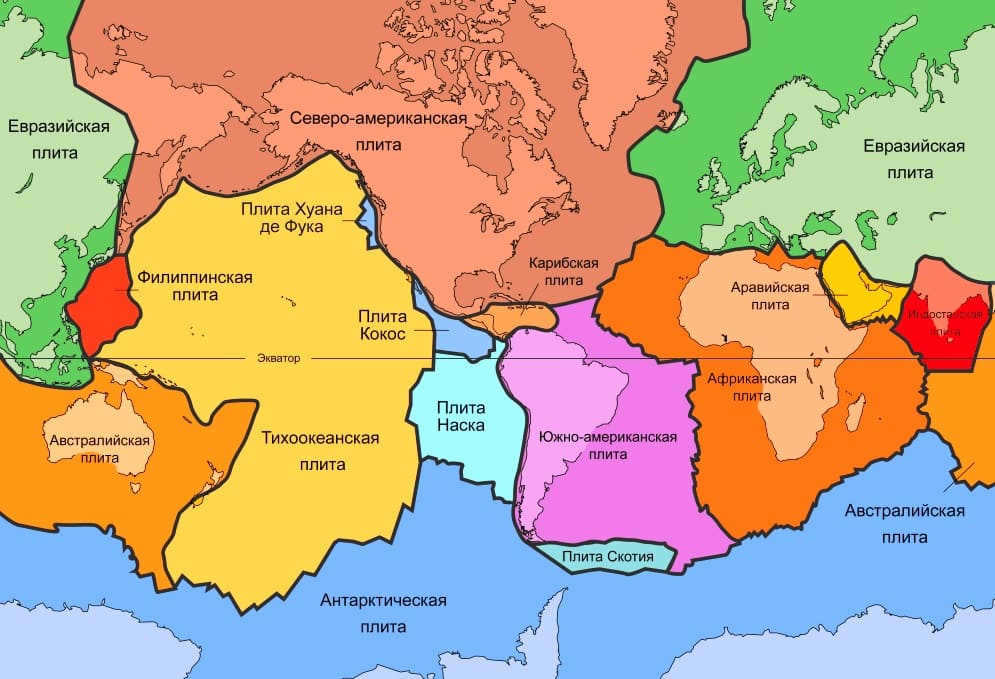
The primary inventory of lithospheric plates consists of enormous blocks with an area exceeding 20 million square kilometers. These blocks encompass a significant portion of the continental mass and house the world’s oceans.
- The Pacific Plate is a tectonic plate situated beneath the Pacific Ocean, spanning 103,300,000 square kilometers;
- North American tectonic platform encompasses the continents of North America, eastern Eurasia, and Greenland, totaling 75,900,000 square kilometers;
- Eurasian platform is a tectonic block that includes a section of the Eurasian continent, covering 67,800,000 square kilometers;
- African plate underlies Africa, spanning 61,300,000 square kilometers;
- Antarctic plate constitutes the continent of Antarctica and the ocean floor beneath the surrounding oceans, with a total area of 60,900,000 square kilometers;
- Indo-Australian – A significant tectonic plate resulting from the convergence of the Indian and Australian plates, covering an area of 58,900,000 square kilometers. It can be further classified into two distinct sections: the Australian Plate, which was originally part of the ancient continent of Gondwana and spans 47,000,000 square kilometers, and the Indian Plate, also a former component of Gondwana, covering an area of 11,900,000 square kilometers.
- South American – A tectonic platform encompassing a portion of South America and the South Atlantic, with a total area of 43,600,000 square kilometers.
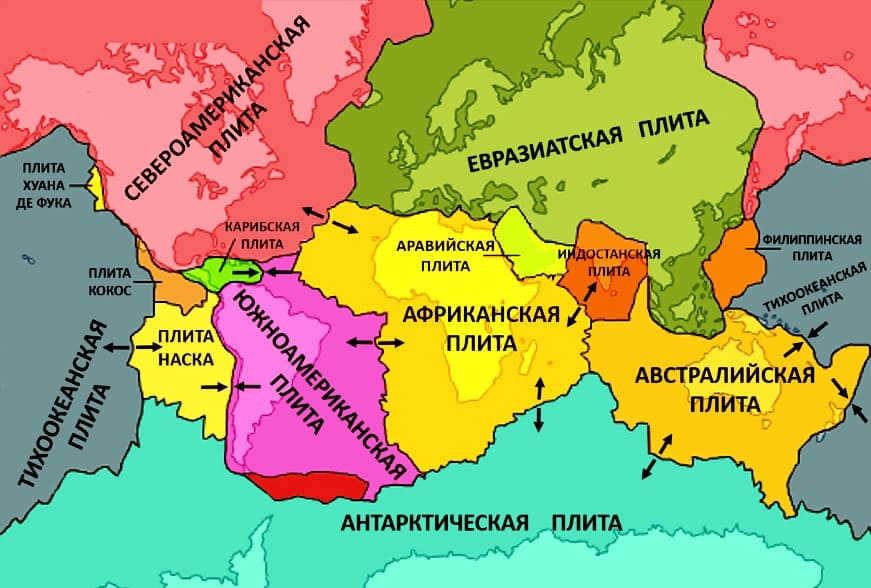
What is the total number of lithospheric plates on earth?
If we consider the Indo-Australian platform as one, there are a total of 7 large lithospheric plates. This particular section of the Earth’s surface is commonly divided into the Indian and Australian plates. Thus, the number of significant blocks becomes 8.
Let’s summarize. The Earth’s lithosphere consists of the crust and the upper, mobile part of the mantle. The Earth’s surface is comprised of both continental and oceanic regions. These regions are further divided into lithospheric plates, which can be visualized as drifting across the mantle like icebergs in the ocean. Take a look at Figure 5, which displays the largest lithospheric plates on a world map. In terms of the number of lithospheric plates on Earth, we can say that there are 8 major platforms with an area exceeding 20 million square kilometers, along with numerous smaller platforms with an area less than 20 million square kilometers. The interactions between these plates greatly impact the structure of the Earth’s surface, which is thoroughly studied by the field of lithospheric plate tectonics.
Below a depth of 20-30 meters, the temperature within the Earth’s crust remains constant, but after that, it starts to rise by approximately 30C for every 100 meters.
Composition of the Earth’s Crust
The Earth’s crust is composed of distinct layers of rocks that vary in their formation, density, and depth.
| Sedimentary | Formed through the accumulation of sediments such as silt, organic remains, and weathering products like clays, limestone, coquina, sand, salt, and chalk. | The outermost layer of the Earth’s crust. Composed of loosely packed rocks that are susceptible to weathering and erosion. |
| Granite | Resulting from the solidification of heated magma, forming rocks such as granites and gneisses. | An intermediate layer of the Earth’s crust. It has a crystalline structure and can extend to the Earth’s surface on continents. |
| Basaltic | Formed through volcanic eruptions, resulting in rocks like basalts and gabbro. | Located at the boundary between the crust and mantle. The specific structure of these rocks is not well-studied. |
The sedimentary and granitic layers have been extensively researched and can be observed on the Earth’s surface. However, the basalt layer remains an enigma for scientists. Despite drilling a 10-kilometer ultra-deep well on the Kola Peninsula, the basalt layer’s depth remains elusive.
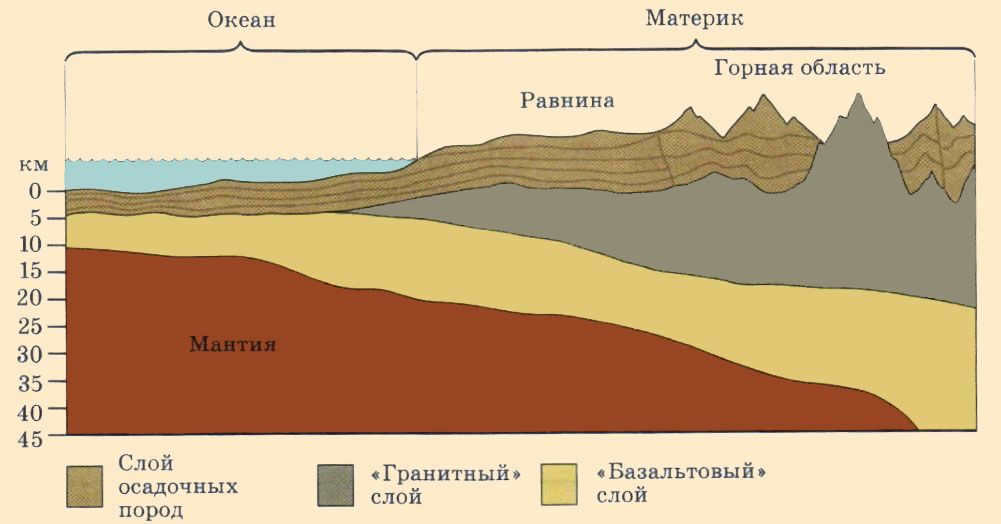
Seismolocation has made it possible to determine the composition of the Earth’s crust. The density and elasticity of rocks influence the speed and direction of seismic waves produced by earthquakes. By analyzing these waves, scientists have been able to identify the different layers that make up the Earth’s crust.
There are two different categories of Earth’s crust – continental and oceanic. The oceanic crust makes up the majority, accounting for 56% of the total crustal area, while the continental crust makes up the remaining 44%.
The continental and oceanic crusts vary in terms of thickness and the number of rock layers they possess.
It is a well-known fact that the continental crust can reach a maximum thickness of 80 km beneath the world’s tallest mountain range, the Himalayas.
Chemical components found in the Earth’s crust
Chemical components that make up the remaining 1% are referred to as dispersed.
Chemical components combine with one another to create compounds that form minerals. The complete inventory of minerals currently identified comprises 6000 designations. However, only 100-150 of them can be categorized as prevalent, while the remainder are exceedingly uncommon.
How the Earth’s crust undergoes changes
Alterations in the Earth’s crust take place due to both external and internal forces:
- Internal forces refer to the energy emanating from the Earth’s interior. Over time, this energy accumulates and eventually bursts forth, resulting in earthquakes and volcanic eruptions.
- External forces, on the other hand, are derived from the energy of the Sun, which is converted into the energy of wind and water. This energy is manifested through temperature variations and serves as the foundation for the ecosystems of living organisms. Under the influence of external forces, mountains erode, solid rocks disintegrate into sand, flowing waters carve deep riverbeds, and valleys are formed. Human activities also constitute external forces.
Transformations in the Earth’s crust transpire at an exceedingly gradual pace, making them imperceptible within the span of a human lifetime.
The Importance of Studying the Earth’s Crust
Geology is the primary scientific discipline that investigates the Earth’s crust as a whole. Its focus includes analyzing the composition, structure, movement, and history of the Earth’s crust, as well as the minerals it contains.
Various minerals, such as coal, oil, and metal ores, play a crucial role in the development of industries and serve as fuel or raw materials for producing essential goods. Discovering new mineral deposits is vital for assessing existing reserves and forecasting their utilization.
By studying the rocks that form the layers of the Earth’s crust, scientists can gain insights into the planet’s historical past. Organic rocks, for example, can offer clues about the ancient organisms that inhabited our planet in the distant past.
How can one create a well-written response? What are the key elements of a good answer?
- Ensure that the answer is accurate and valid;
- Provide a detailed and clear response to maximize its usefulness;
- Demonstrate strong writing skills, as answers that are free from grammatical, spelling, and punctuation errors are more easily comprehended.
The term “navigator” is a masculine noun, and it can be associated with various synonyms.
1. One synonym is “sailor.” The elderly sailor gazed into the distance, contemplating the perilous journey that lay ahead;
2. Another synonym is “the Argonaut.” The Argonaut wore tattered pants and a shirt saturated with the scent of the sea and salt;
3. “The seafarer” is also a synonym. The seasoned sailor was aware that many ships had met their demise in this particular area, as treacherous rocks lay hidden beneath the water’s surface;
4. Finally, “the sea wolf” is another synonym. The aged sea wolf was filled with excitement, as he was about to embark on a lengthy voyage.
Arrange the mountains listed below in increasing order of their highest absolute height: 1) cordilleras, 2) the great watershed ridge, 3) the Himalaya peaks.
Ilya was taking a test at the Olympis school. The boy had to match a continent with a river that runs through it.
To calculate the length of the highway between two cities on a map with a scale of 1:20,000,000, if on a map with a scale of 1:5,000,000 it is 9 cm, the options are: A) 22.5 cm, B) 45 cm, C) 4.5 cm, D) 2.25 cm.
The Earth has a layered internal structure, consisting of solid shells: the crust, the viscous mantle, and the metallic core.
The thickness of the Earth’s crust varies from a few kilometers in oceanic areas to tens of kilometers in mountainous areas.
Our planet is composed of three main layers: the core, the mantle, and the crust. The core makes up about 17% of the Earth’s volume and is located at the center. The mantle accounts for approximately 82% of the Earth’s volume and surrounds the core. The crust, which is the outermost layer, makes up only 1% of the Earth’s volume.
The Earth’s crust is divided into two types: continental and oceanic. These two types of crust have distinct characteristics. The oceanic crust is thinner, ranging from 7 to 10 kilometers in thickness. It is composed of two layers: basalt, which is located below, and sedimentary, which is located above. On the other hand, the continental crust is much thicker, reaching up to 70 kilometers under mountain ranges. It consists of three layers: basalt, granite in the middle, and sedimentary.
In the United States, there are three major economic regions: the North, the South, and the West.
The North is home to various industries including printing, oil refining, chemical manufacturing, mechanical engineering, metallurgy, petrochemicals, clothing production, and shipbuilding.
The Southern region is known for its industries such as oil refining, petrochemicals, and non-ferrous metallurgy, particularly aluminum production.
The reasons for these differences are due to the geographical location, natural conditions, resource potential, and development based on the needs of the population.
It is situated approximately 180 degrees along the meridian. It consistently traverses through the ocean and occasionally deviates from the 180th meridian due to the lack of a universal agreement on its exact placement.
Moreover, if we consider the meridian length of North America to be 4598 km and the length of South America to be 4672 km, when we add these figures together, we obtain a total length of 9269 km. Similarly, on the parallel, the length measures 3089 km for North America and 2067 km for South America.
Here are some notable locations along this meridian:
- Tierra del Fuego – 48,692 Tierra del Fuego, Chile, Argentina
- East Falkland – 6,605 Falkland Islands, disputed between Great Britain and Argentina
- Isabela – 4,588 Galapagos Archipelago, Ecuador
- West Falkland Islands – 4,532 Falkland Islands, disputed between United Kingdom and Argentina

The Earth’s crust is the uppermost part of the lithosphere. When considering the entire planet, this portion appears to be a thin layer. However, even this thin layer remains poorly understood. Nevertheless, scientists have successfully determined that the Earth’s crust is thinnest beneath the oceans and seas.
The deepest wells ever drilled into the Earth’s crust reach depths of up to ten kilometers. These measurements do not provide scientists with enough information about its structure and composition. Information about the composition of the lithosphere can only be obtained through seismolocation. By deciphering seismic waves, scientists have been able to estimate the density and composition of the Earth’s layers.
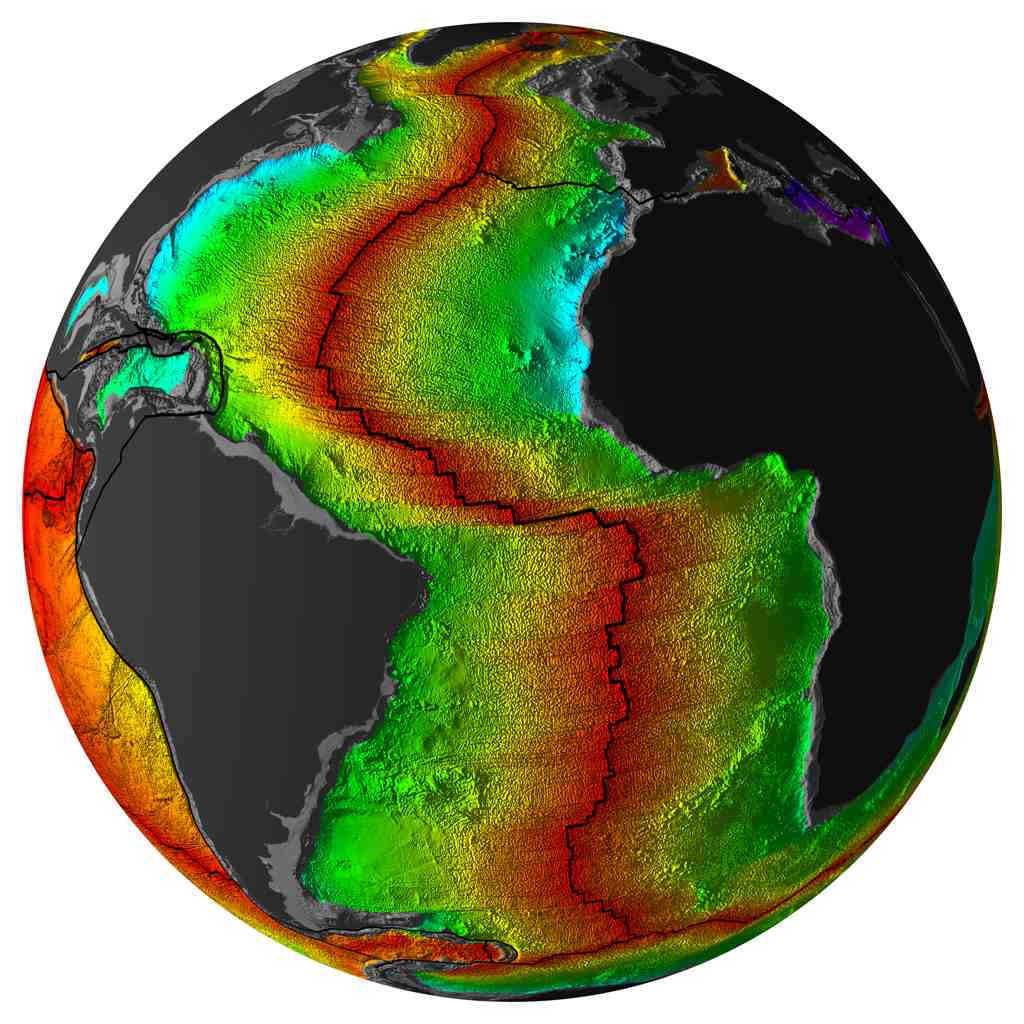
Earth's crust
The Earth’s crust varies in thickness across different regions of the world. It is thicker above the continents compared to beneath the oceans. On average, the continental crust measures around 35 kilometers in thickness. However, in mountainous areas, it can be significantly thicker, reaching 80 kilometers or more. Conversely, the crust beneath deep waters has the thinnest measurement, typically around 15 kilometers.
Aside from the variation in thickness, the continental and oceanic crusts possess distinct characteristics and structures. The continental crust is composed of the following layers:
- a lower layer consisting of basalt (approximately 15 km thick);
- a middle layer composed of granite (around 10 kilometers thick);
- an upper sedimentary layer formed from the decayed products of crystalline rock (about 5 km thick).
Overall, the continental crust has a thickness of 30-40 km.
The oceanic crust, on the other hand, is comprised of the following layers:
- an upper sedimentary layer with depths of up to one kilometer;
- a middle sedimentary layer with a composition that is not well understood;
- a lower basaltic crust that extends to a depth of approximately five kilometers.
All in all, the oceanic crust has a thickness of about 15 kilometers.
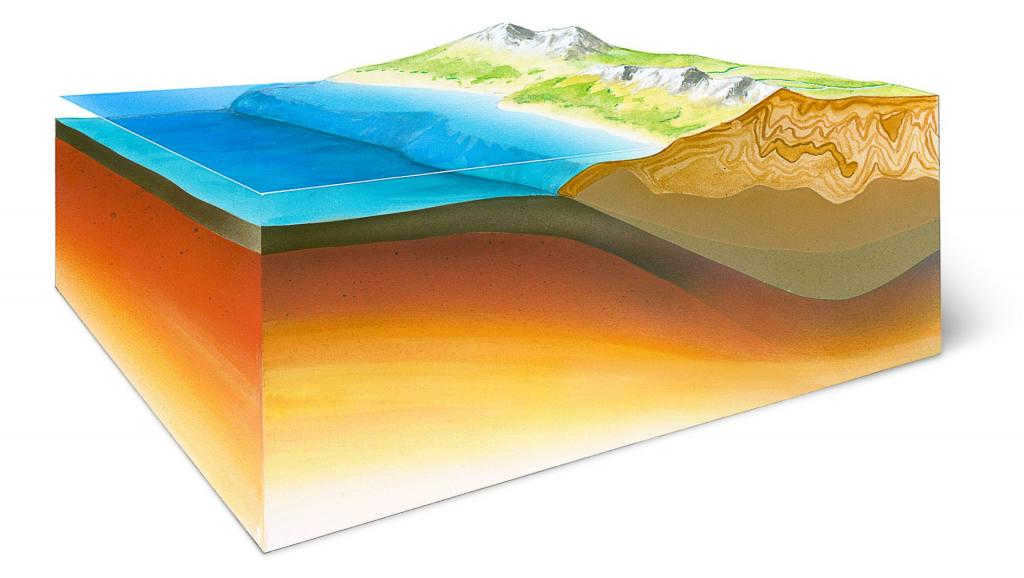
Zone of Transition
Between the continental and oceanic layers, there exists a zone of transition where the granite layer undergoes displacement. The boundary between these layers is not always clearly defined. In certain regions, there is a gradual shift from the oceanic to continental crust. One example of this can be seen in the transition from the Far Eastern seas to the edges of lithospheric plates. In this particular location, the Earth’s crust is the thinnest, lacking a granite layer, though the upper sedimentary layer is well-developed. The overall thickness of the crust measures approximately 15 kilometers.
The ridges elevate above the oceans for multiple kilometers, with a length that extends up to 80 thousand kilometers. These ridges are divided by faults. Within the ridge zones, there is a substantial amount of seismic activity and volcanic processes can be observed. In this region, magma consistently erupts, dispersing in various directions through underwater lava flows.
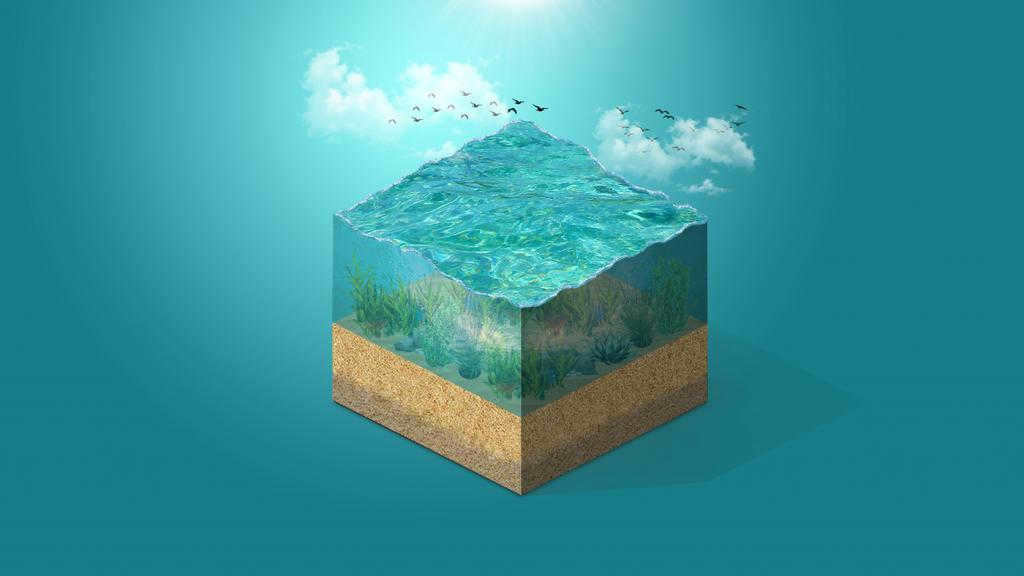
Transition Zone Regions
Between the locations of the thinnest and thickest Earth’s crust, there are regions of transition. Several categories can be identified:
- Vityazevsky. This type of transition region is characterized by the absence of a prominent island arc, a shallow trough depth, and minimal seismic activity.
- Mariana transition region. It is clearly manifested as an underwater ridge. The trough depth is significant. This transition region experiences high seismological activity and volcanism. The sedimentary layer is comparatively thin.
- The Japanese type is distinguished by the amalgamation of island arcs of various ages, accompanied by intense volcanic and seismic activity. This type also exhibits similarities in crustal structure to the continental type, with the basins having a substantial sedimentary layer at the bottom.
Another transitional type, known as the Mediterranean type, shares similar characteristics with the continental type in terms of crustal structure.
